When I was a kid, I desperately wanted to read Stephen King books. I was drawn to the horror and mythos. My older brother had read IT and told me all about it. The idea of a shapeshifting killer clown appealed to me, even though it haunted my nightmares. My folks determined, probably correctly, that King was a bit too mature for 12-year-old me. With them forbidding me from reading the master of horror, the desire quickly abated in me and I immediately moved on to other things…No, of course that’s not what happened. That just made me want to read his work even more. The first King story I tackled was Misery. The excellent Rob Reiner film starring Kathy Bates and James Caan had just hit theatres and I couldn’t wait to devour the story. Misery, remains one of my favourite Kings to this day, perhaps in part because I had to read it in secret.
One weekend when my friend’s parents were away, we decided we were going to ‘party’ by renting a horror movie. So often I had perused the horror section of my local Video 99 and marvelled at the various covers wondering what terrors lied within. Horror movie covers are an art all onto their own, but one always drew me in. The Shining, with Jack Nicholson’s deranged face glaring with glee through the jagged hole in a door. You know the scene: “Here’s Johnny!”
We watched the movie and it stuck with me. To this day when I watch the opening credits, the unsettling music peppered with ghostly screams, and the overhead shots following the family car heading towards the Overlook Hotel freak me out. King famously hated the adaptation by Stanley Kubrick, but it stands the test of time a cinematic masterpiece and one of the scariest movies ever made. It leaves us with unanswered questions and lingering dread. The movie is different than the book, but no less terrifying.
Board games based on popular books, movies, TV shows, and video games, have traditionally been considered, how to put this? Shitty. It’s likely because for years there were countless skins of popular IPs thrown onto previously existing games. How many Star Wars Monopolys or Harry Potter Trivial Pursuits do we need in this world? One of the issues is that the people controlling the IPs often don’t have any experience with the world of board games. It’s easier, faster, and cheaper to slap some pre-existing art onto a pre-existing game and you’re off to the races.
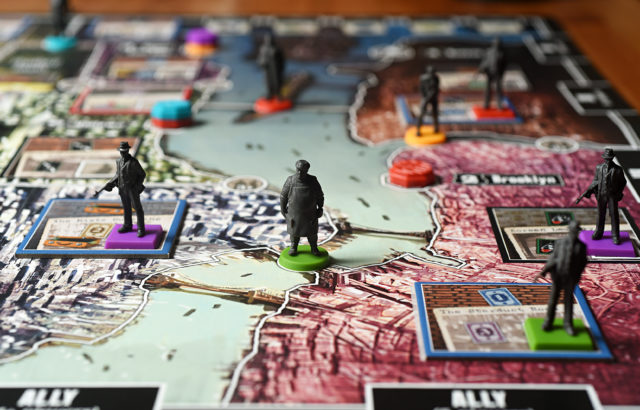
It’s taken some time to rehabilitate the reputation of licensed games, but publishers and designers have started to approach these types of games with a lot more care. Titles like The Godfather: Corleone’s Empire, the Legendary series, A Game of Thrones: The Board Game, and Battlestar Galactica have shown that being a licensed game is not necessarily the mark of a bad game. In fact, in those titles I mentioned, there are a number of great ones.
One of the leading forces behind the new quality in games based on IPs is the design studio Prospero Hall. In recent years, they’ve had some surprise hits like Harry Potter: Hogwart’s Battle, Villainous, and Bob Ross: Art of Chill. They have a talent of creating accessible games that appeal to both fans of the IP and board game enthusiasts alike. The most important thing is the obvious care they take to create an actual game that reflects the title, rather than just slapping a theme on another heartless dice chucker.
The Shining by Prospero Hall arrived to me with a few other games that I had been eagerly awaiting. It was the first game I saw when I opened the box and boy, was I ever excited. Right off the bat, the cover of the game is super beautiful. That blend of the iconic hotel carpet, with Danny innocently playing with his trucks, melting into a wide shot of the Overlook Hotel and everything is awash in an almost blood-like orange. I could almost hear that opening theme in my head. Pulling off the box lid, the very first thing you see is the rulebook, and I can’t tell you how smart and cool the design is to have nothing but:
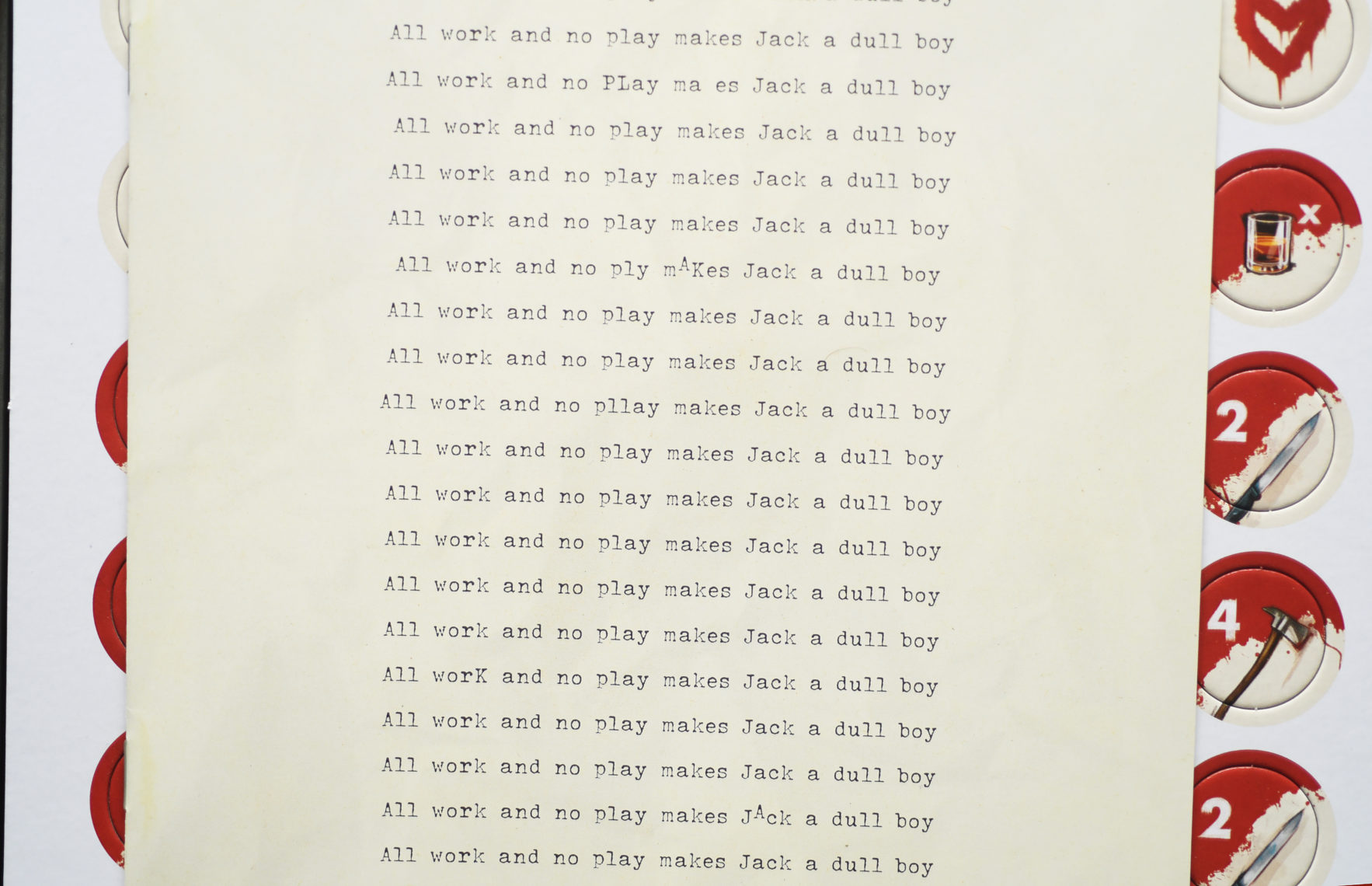
Little touches like this make you feel that the producers of the game are also fans and that they’re going to do it justice.
The Shining is a cooperative game in the standard mode. Three to five players are family members trying to survive four months snowed in at the Overlook (five months if you want a real challenge). You work together to resist the power of the hotel and avoid becoming possessed. You start off with three health tokens, and if any of you should run out, it’s game over for the whole team.
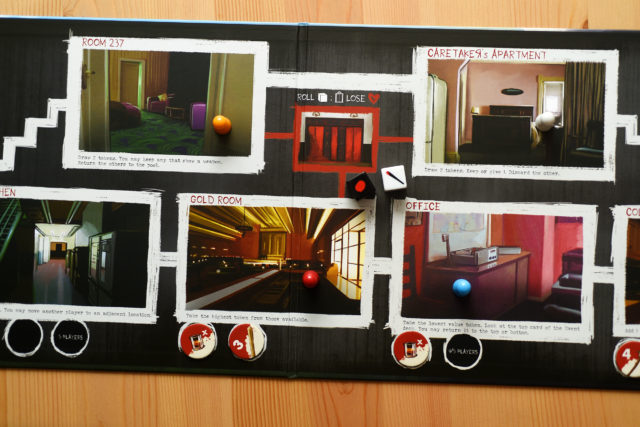
The hotel board is made up of seven connected rooms including Room 237, The Gold Room, and the Hedge Maze. Each has their own action associated with them. You can get up to the second floor through the Kitchen or the Colorado Room, leading to Room 237 or the Caretaker’s apartment. You can also test your luck and take the elevator.
Months start with the first player (holding the 237 room key) reading the top card from the Event deck. Then players in turn order move to a new room and take an action. Moving to an adjacent room is free, but if you want to travel further down the empty hallways, you must discard a Willpower token for each additional room you move through. If you want to take the elevator (and why would you? You’ve seen the movie), you must roll the white die and on a result of the elevator doors, you’ve been wounded and must lose a health token.
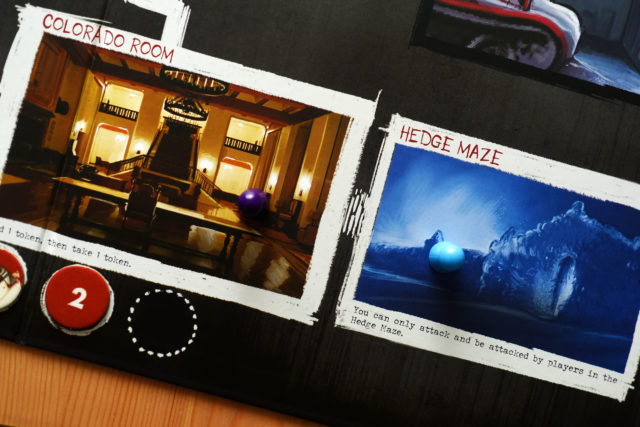
Some of the room actions allow you to affect other players on the board, like the Kitchen where you take a Willpower token and move another player to an adjacent room. In the Office you can look at the top card of the Event deck and either leave it or put it on the bottom. If you’re in the Hedge Maze, you can only attack or be attacked by other players in the Maze. Oh yeah, this is a co-op where you might end up attacking your teammates.
After every player has had a turn, another Event card is drawn. If its colour matches a previously revealed Event card, this will be the last round of the month. There are only two different colours, so each month lasts a maximum of two or three rounds.
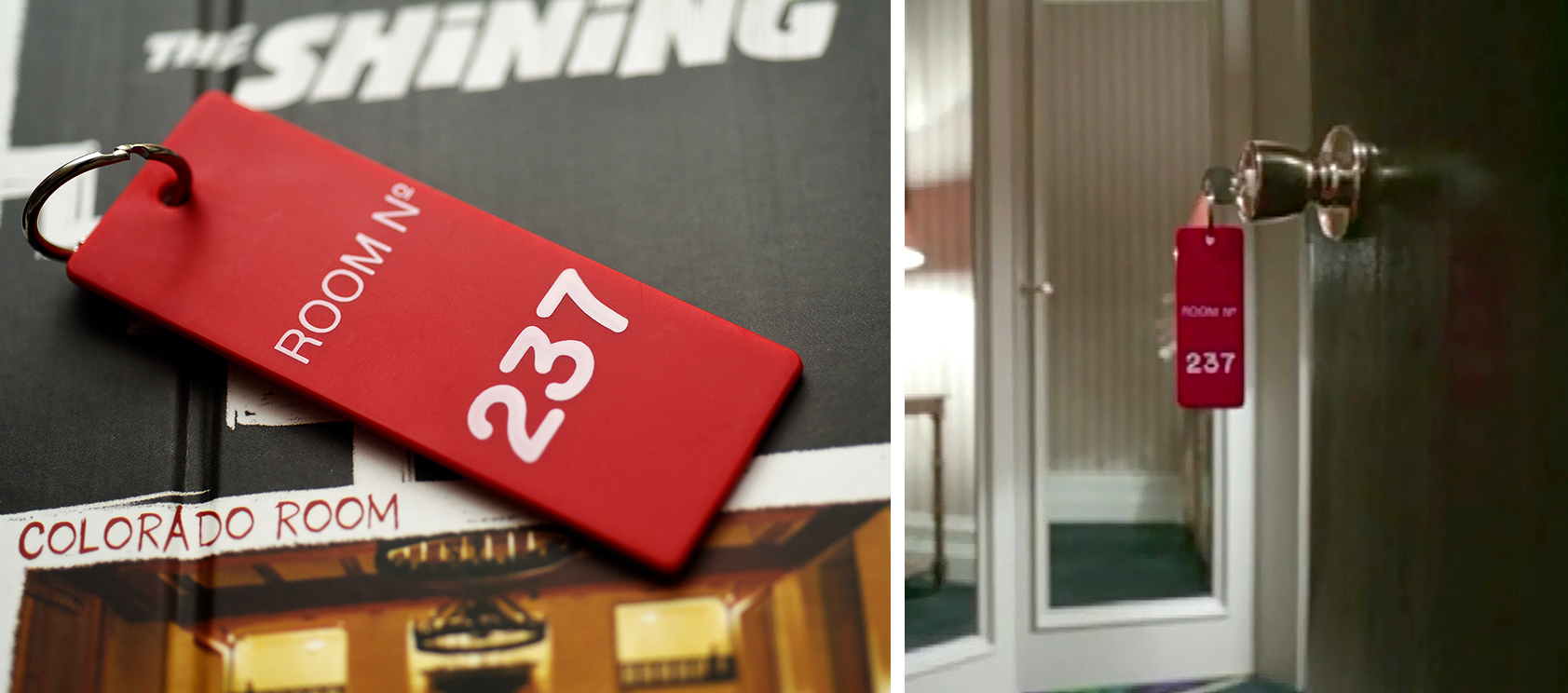
As the month comes to an end, you play the Shining phase. You add the value of the Willpower tokens you’ve collected and reveal the Shining cards you were dealt at the start of the round. If your Willpower meets or exceeds the Shining total, the good news! You don’t want to kill your family members this round. If, however, the Shining total is higher, then it’s time for them to take their medicine. You must move to the closest teammate and roll the White and the Black die. Blood spatter results on the black die cost attacked players a health as well as any white die that depicts a weapon that the attacker is carrying.
Assuming no one has died, the start player key is advanced and a new round begins.
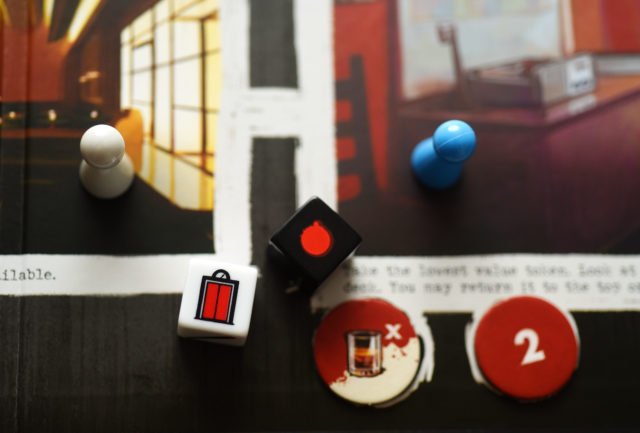
You can also play the Corrupted variant where everyone is secretly dealt an identity card. One of you will be the Corrupted trying to kill off one of the other Caretakers. Of course, the goal is to hide your identity for as long as possible. In this variant, information is largely hidden. When you draw an Event card, you can freely talk about what you see, but the card is never revealed. You’re free to lie if it will give you an advantage. During a game the players may make only one accusation of the Corrupted player. If they are discovered, they must reveal their identity and a few things change. First, everyone gets +1 to their willpower for the rest of the game. The Corrupted player can no longer be attacked by possessed players and they can only move one room per round. The Corrupted player can still win if one of the caretakers dies over the winter. If an incorrect accusation is made, paranoia permeates the hotel and +1 is added to players’ Shining total for the rest of the game. Better be careful who you trust.
Everything about The Shining is beautiful and on point. From the art, to the presentation, to the theme, it all works well together. I particularly like how when folded, the back of the board shows the Overlook during summer and when you open the first flap the same scene is transformed into a freezing cold landscape covered in snow. Fans of the movie are going to revel in this execution.
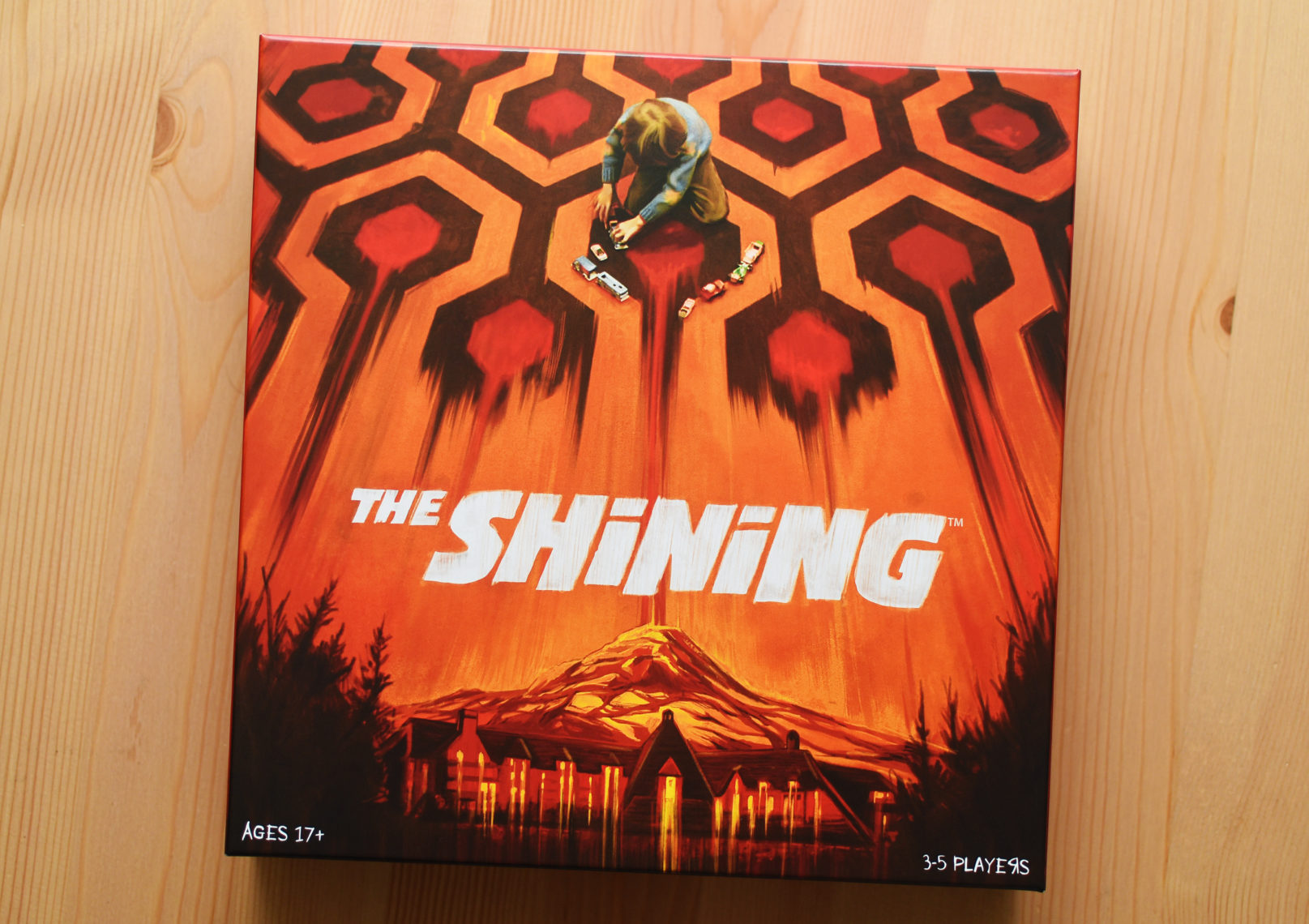
The gameplay of The Shining is a little less impressive. It’s simple enough to learn, and goes by relatively quickly, but the seasoned gaming groups that I played with attacked the hotel with smarts and strategy that left the decades-old ghost in our dust. It never felt like we were in danger of losing. We had fun with it, but more for the novelty of what we were playing rather than the outstanding gameplay itself.
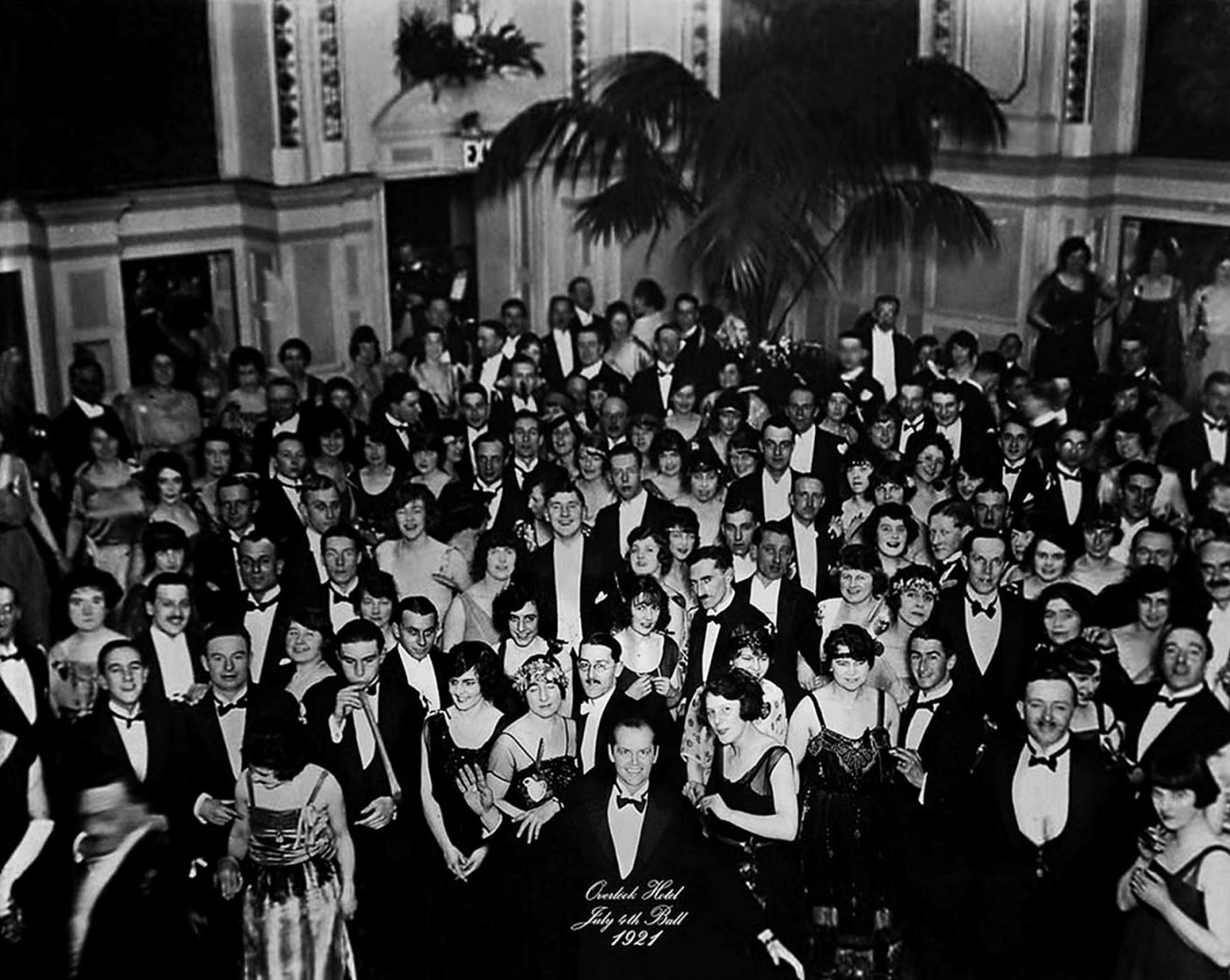
Maybe you’re a diehard Stephen King or Stanley Kubrick fan. Perhaps you want to add a little horror to your collection. Maybe you just want a good game to pull out every Halloween to get a little spooky. I think players new to cooperative games will really love The Shining as well as fans of the genre. If you don’t consider yourself either of those, you may prefer to head to a beach rather than the mountains.
The Shining is a cooperative game for 3-5 players. Thank you to Asmodee USA for providing a media copy of The Shining for this article.
Thanks for the review. I’m not big on co-ops so probably not something I would play. However, your review got me thinking of the movie (in addition to the game) and how long its been since I first watched it. I was probably 11 or 12 when The Shining was released and I watched it on cable a year or so later. It ‘creeped’ me out enough that I have not watched it since. I think I should give it another look and see how the movie has aged and if I view it differently through a middle aged adult’s eyes.
What you describe with the cool back of the board art work when it is folded and you first open the game is repeated in Wonder Woman Challenge of the Amazons, as well as Horrified. I like this signature dimension and touch that unifies these Prospero Hall/Ravensberger games. Less impressive I felt was Jurassic Park Danger and Jaws, however these are all much better than what popular I.P. game designers came up with 15 years ago. We’ve grow so much, it’s great, and the Thanos Rising and Harry Potter franchise stuff by THE OP is further proof that getting non-gamers and casual gamers to try more complex games fr ombig box stores is more and more possible every year!